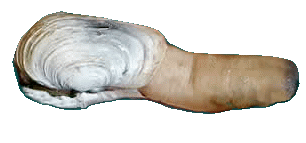Interesting Geoduck Facts
|
Latin name:
Panopea abrupta (Conrad, 1849) |
 |
Interesting Geoduck Facts
|
Latin name:
Panopea abrupta (Conrad, 1849) |
 |
"The common
name for geoduck has a native American origin, meaning "dig deep",
a reference to humans or sea otters digging them. The scientific name
is Panopea abrupta (Conrad, 1849) and I believe it is the largest
intertidal clam in the world. It is the largest species of Panopea."
Harbo, R.1997.Shells and Shellfish of the
Pacific Northwest".
The geoduck clam is sometimes spelled: goeduck, goiduck, or gweduck.
The Chinese call the geoduck the "elephant trunk clam"
Native to the northern
Pacific coasts of Canada and the United States of America, that is, along
the coasts of Washington state and the province of British Columbia. About
109 million adult geoducks are packed into Puget Sound's sediments
the biggest bunch of marine animals in the Sound.
Huge geoducks have been
recorded weighing up to 4.5 kg (10 lbs) Hand et
al.1996, Harbo 1997 with larger denizens of the deep reported by
fishermen in the field. (Source)
The
maximum
documented weight: 7.15 kgs. (Sources differ on this point)
The valves,
or two parts of the shell, are always open in the adult, because the
body and siphons are too large to be retracted.
Age and growth
studies have shown that geoduck clams grow about one inch per year in
shell length for the first four years of life. The growth rate is gradually
reduced after this time. The average size of 2.2 pounds is reached in
five to six years.
Average Age: Adults may live to over 140 years and reach a maximum shell length of 23 cm. Geoducks are among the longest-lived animals in the world. Growth-ring analysis shows many individuals live for more than 100 years. They grow rapidly in the first 10-15 years (approximately 1 inch per year), after which time the growth in shell length almost ceases and is replaced by a thickening of the shell and a slow increase in body weight.
Oldest Recorded Age: 146 to 168 years (sources differ on this point).
Geoducks are most
often found at depths between 10 and 80 feet below the mean low tide mark,
but have been reported at depths reaching 360 feet. Average depths from
another source: subtidal, from 8 to 120 m depth
They bury themselves
up to a meter deep in sand, silt, gravel and other soft substrates. A developing
geoduck will burrow into sediment at an approximate rate of 1 foot per year.
After digging about 3 feet deep, the adult geoduck settles in for 100 years
or more.
Siphons and neck
cannot be withdrawn into their shell. In burrowed adults, the siphon may
stretch 39 inches to the sea bed.
Geoducks have separate sexes. Spawning occurs annually, primarily from Late April to July, when waters are warm. Females release from 7-10 million eggs, which develop through several stages in the water column until settling on the bottom within 40-50 days. At a shell length of 2 mm, they burrow into the substrate and can bury to a refuge depth of 60 cm in two years. They are sexually mature by 3 yrs.
The of the geoduck is thin, it lacks teeth, and it may attain a length of 8 in. (20 cm). The valves, or two parts of the shell, are always open in the adult, because the body and siphons are too large to be retracted.
The geoduck feeds on phytoplankton (single-celled marine algae), mostly diatoms and flagellates. Due to it's diet, one must be careful of paralytic shellfish poison (PSP) or "red tides". Check with autorities if unsure wheter or not there is a red tide before attempting to invite a geoduck for lunch. Red tides are harmless to the clams, but they can be fatal to humans.
Mirugai Sushi:
Source
Predators: sea stars, crabs, fishes, and birds.
Resources Used for this Page and Other Sites on the Geoduck:
Comments From My Viewers